包阅导读总结
1. 关键词:Java、编程语言、相关挑战、应用领域、开发者
2. 总结:本文探讨了 Java 在当今的相关性,包括其在编程语言中的排名、应用领域、使用者情况、学习原因以及开发者的工作生活特点,指出 Java 依然强大,有学习价值。
3. 主要内容:
– Java 的现状:
– 面临跟上时代发展等挑战。
– 新语言不断出现,Java 仍受欢迎。
– Java 在语言中的排名:
– 2023 年,49%开发者使用,是最受欢迎的主要语言之一。
– 过去 7 年,47%-54%开发者持续使用,稳定性高。
– Java 的应用:
– 适用于创建网站、工具等。
– 在 IT 相关及非 IT 相关的多个行业广泛使用。
– Java 的使用者:
– 全球约 460 万专业开发者,主要来自中、印、美等国。
– 多数全职工作,有多种职业角色。
– 偏好特定的开发工具和操作系统。
– 学习 Java 的原因:
– 就业机会多,薪资待遇好。
– 提供编程基础,利于学习其他语言。
– Java 开发者的工作外情况:
– 多数傍晚结束工作,但 16%工作到深夜。
– 70%周末也为兴趣编码。
– 有多种爱好和兴趣。
思维导图: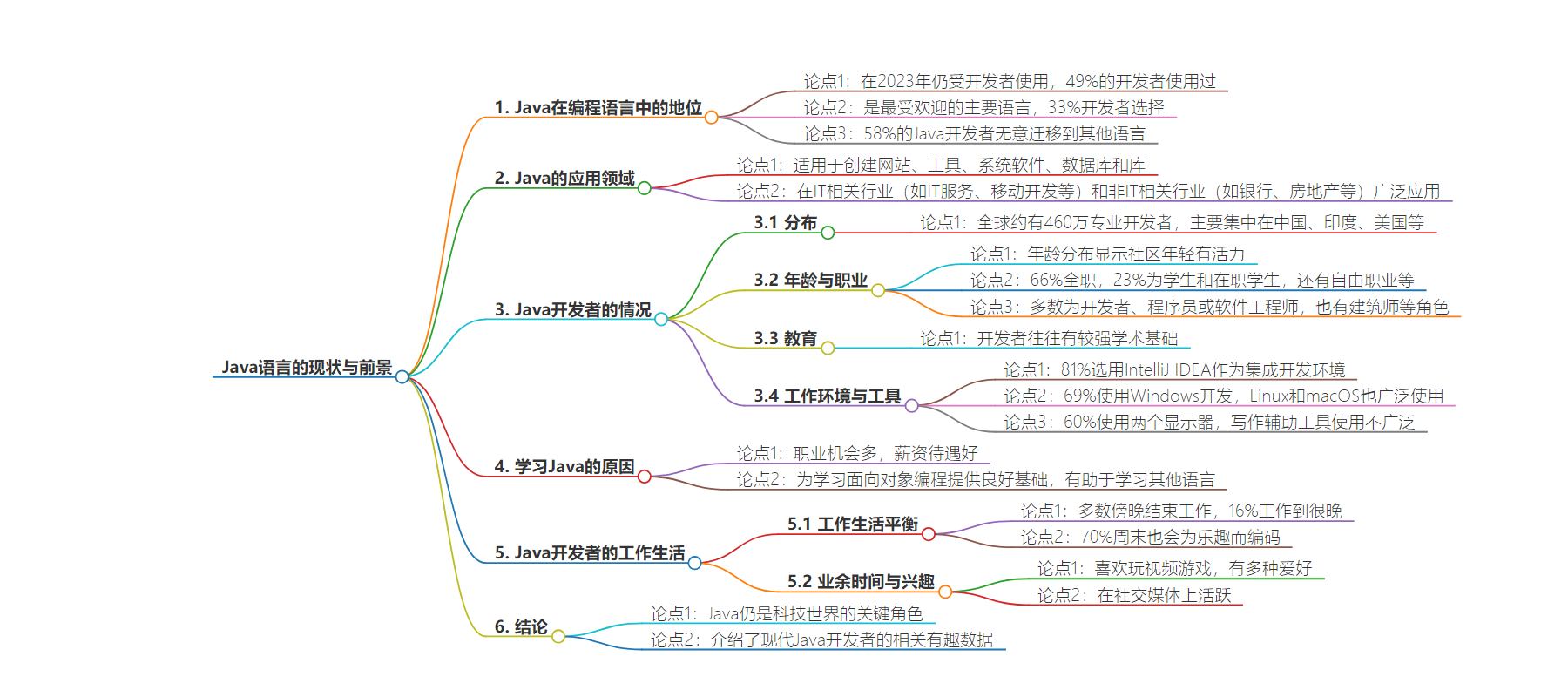
文章地址:https://blog.jetbrains.com/idea/2024/07/is-java-still-relevant-nowadays/
文章来源:blog.jetbrains.com
作者:Irina Mariasova
发布时间:2024/7/26 13:31
语言:英文
总字数:1397字
预计阅读时间:6分钟
评分:87分
标签:Java,编程语言,开发者生态系统,职业机会,JetBrains
以下为原文内容
本内容来源于用户推荐转载,旨在分享知识与观点,如有侵权请联系删除 联系邮箱 media@ilingban.com
Is Java Still Relevant Nowadays?
Read this post in other languages:
One of the biggest challenges for technologies nowadays is keeping up to date with the latest developments, remaining relevant to the demands of modern business, and continuing to provide added value for users. The world is changing faster than ever before, and the pace of this change shows no signs of slowing.
As a major programming language, Java is also subject to these challenges. Newer, simplified languages are introduced regularly. Can Java keep its crown? Is there still potential for those just starting their development careers with Java?
In this blog post that brings together data from The State of Developer Ecosystem 2023 and The State of Developer Ecosystem 2022 reports*, we’ll learn the answers to these questions and more. We’ll look at how Java stacks up against other languages, find out what sectors use it and for what products, provide data that can help you decide whether this language is worth learning, and, as a bonus, share an example Java developer profile to see if you can relate.
How does Java rank among other languages?
According to the JetBrains Developer Ecosystem Survey 2023, Java continues to shine in the programming world with 49% of developers who have been using it over 2023.
It also secures its place as the most popular primary language* – 33% of developers choose it as their main tool! Notably, 58% of Java developers have no intention of migrating to other languages, highlighting Java’s reliability.
* The list contains programming, scripting, and markup languages.
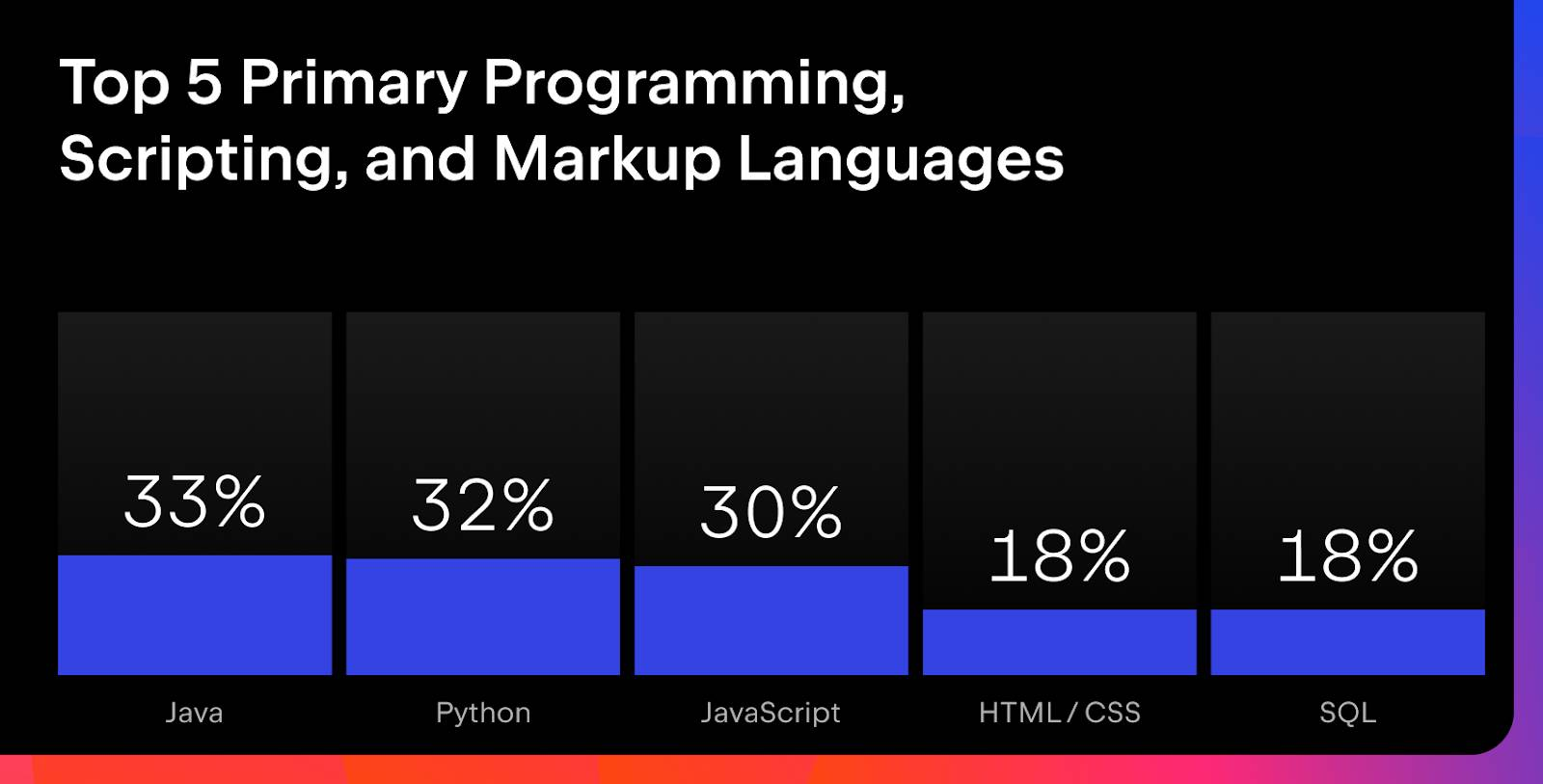
Despite new languages emerging, Java is still strong. Between 47% and 54% of developers have consistently used Java over the last seven years, indicating its stability. Its ongoing updates and broad applications across multiple industries mean Java skills will stay valuable for years to come. Companies like JetBrains support and improve the Java ecosystem, ensuring it continues to be relevant and important.
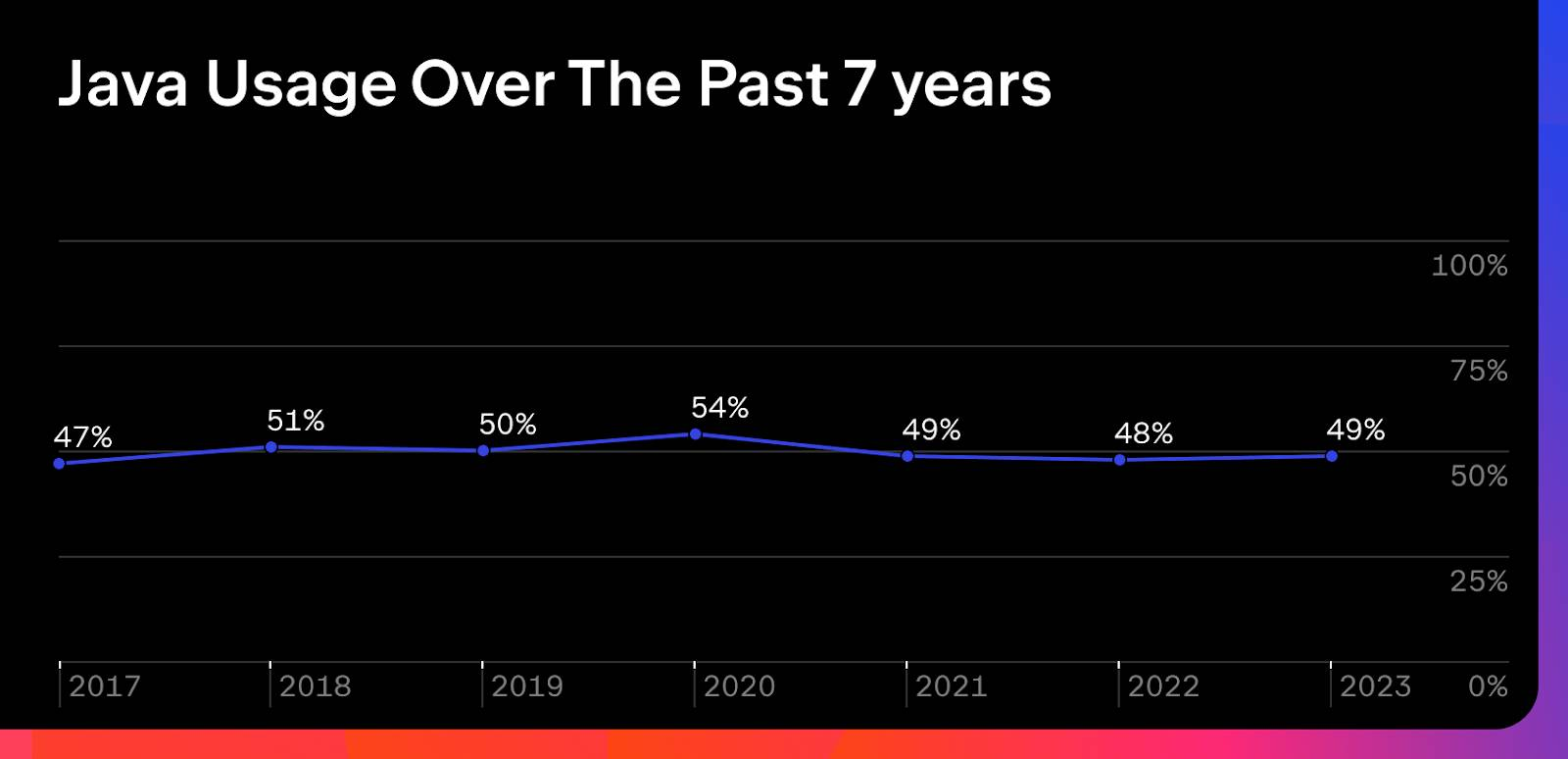
What is Java used for?
Java’s vast set of features and frameworks make it most suitable for creating websites, utilities, system software, databases, and libraries, as highlighted by recent trends in the developer community in The State of Developer Ecosystem 2023 survey.
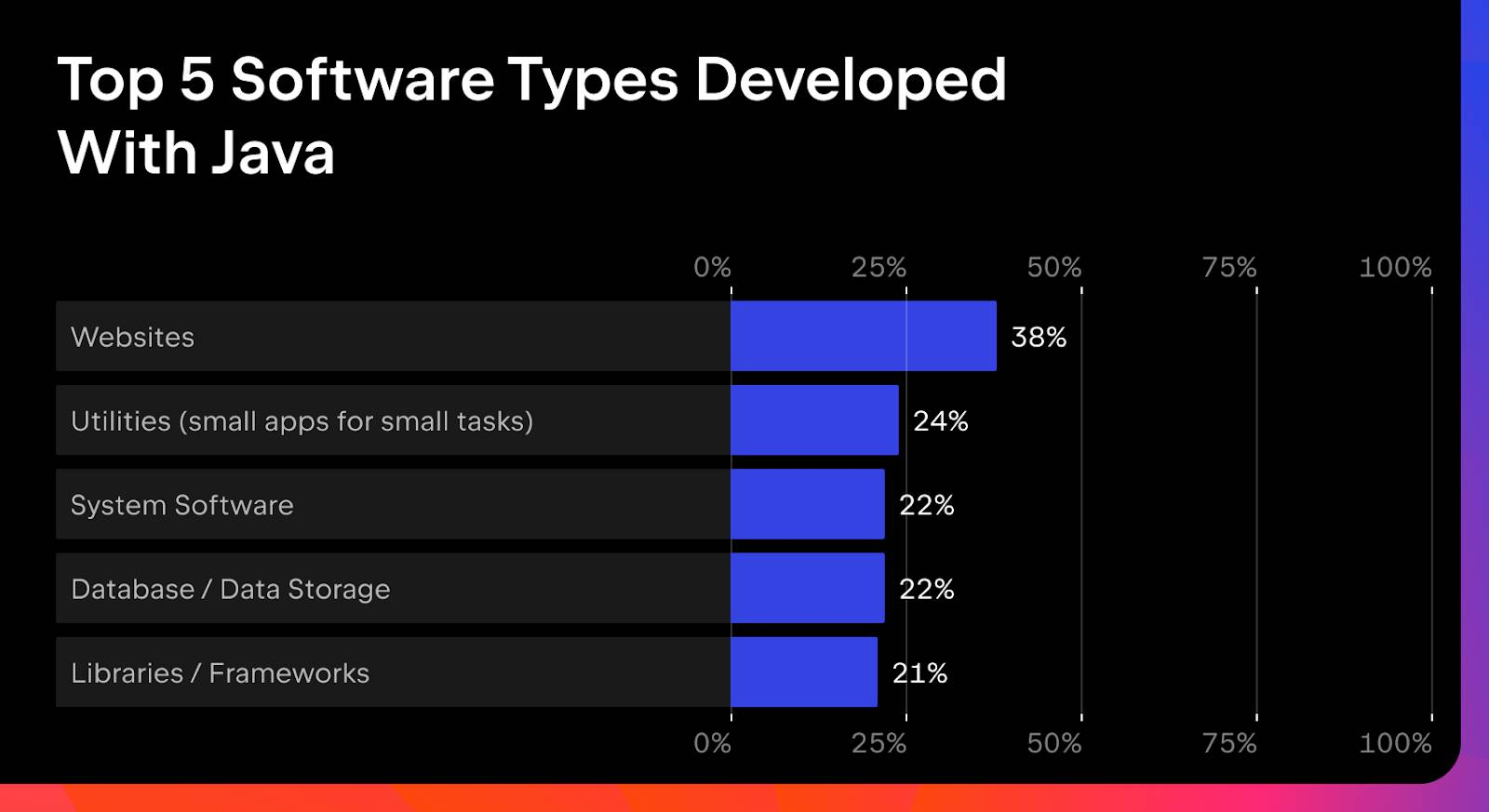
73% of respondents answered that IT is their company’s core business. Among IT-related industries, the most popular ones are IT services, mobile development, cloud computing, fintech, and big data. Developers working in non-IT-related industries most frequently work in banking, real estate, mortgage financing, accounting, finance, and insurance. Beyond these, other popular sectors include education and manufacturing, medicine and health, as well as sales, distribution, and retail.
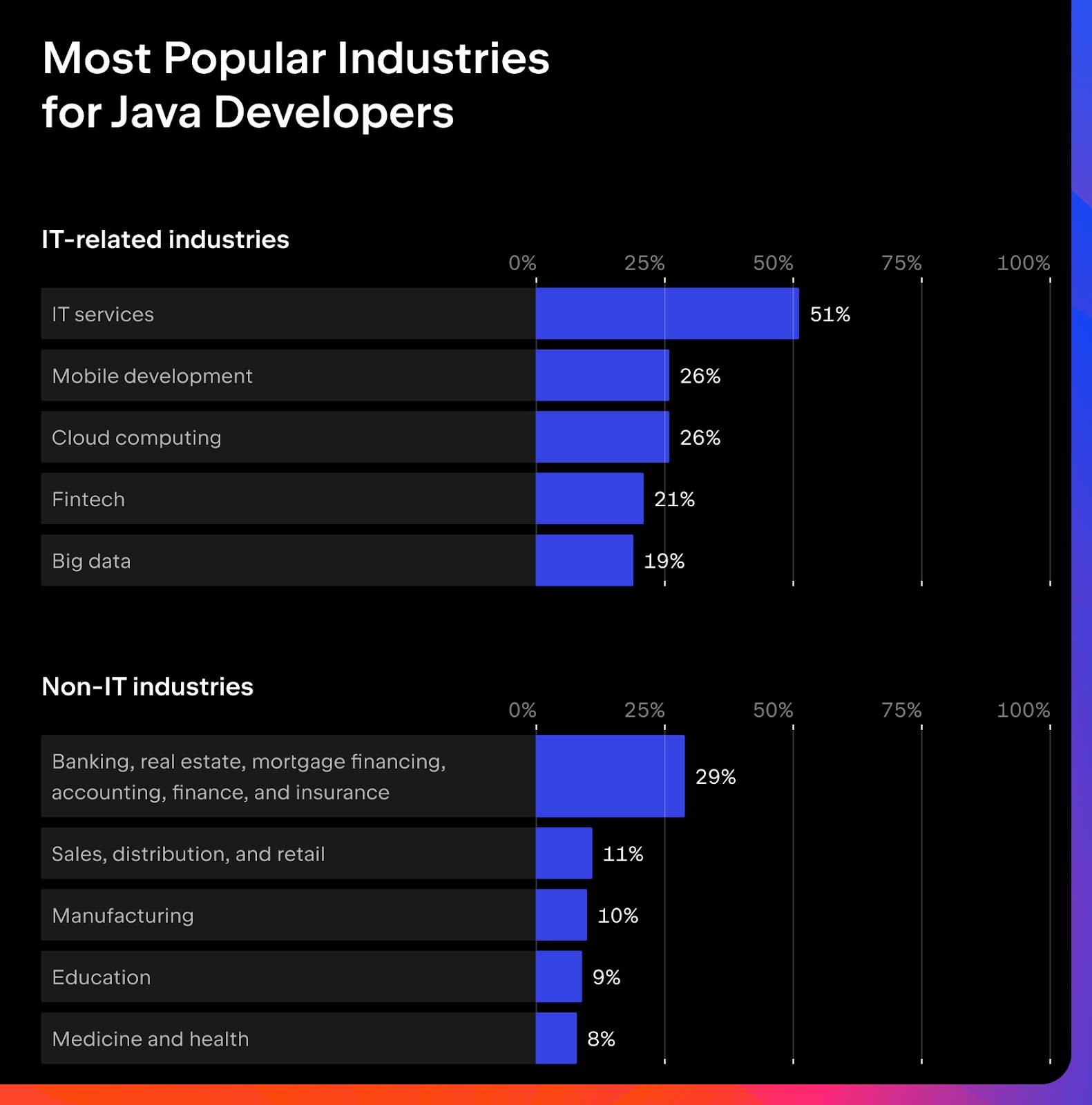
As you see, Java is used in the most critical economic sectors. Its platform independence and strong enterprise support make it perfect for managing complex data in these industries.
Who uses Java?
According to our estimations, there are 4.6M professional Java developers in the world, with the majority of them based in China, India, the United States, Japan, Germany, and South Korea.
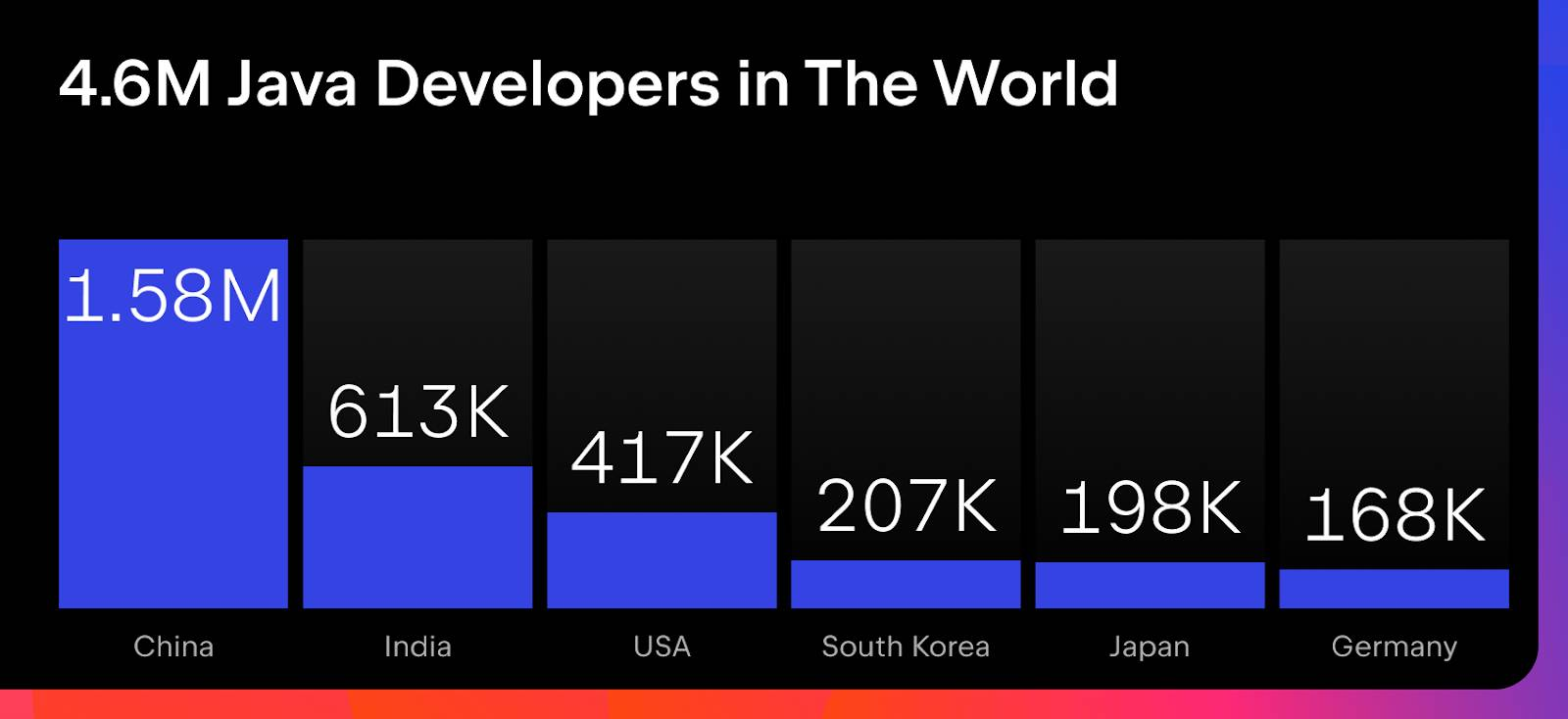
Based on recent survey data, here’s an overview of the typical Java developer’s age, occupation, education, and preferred tools.
Age
The age distribution of Java developers indicates a young and vibrant community.
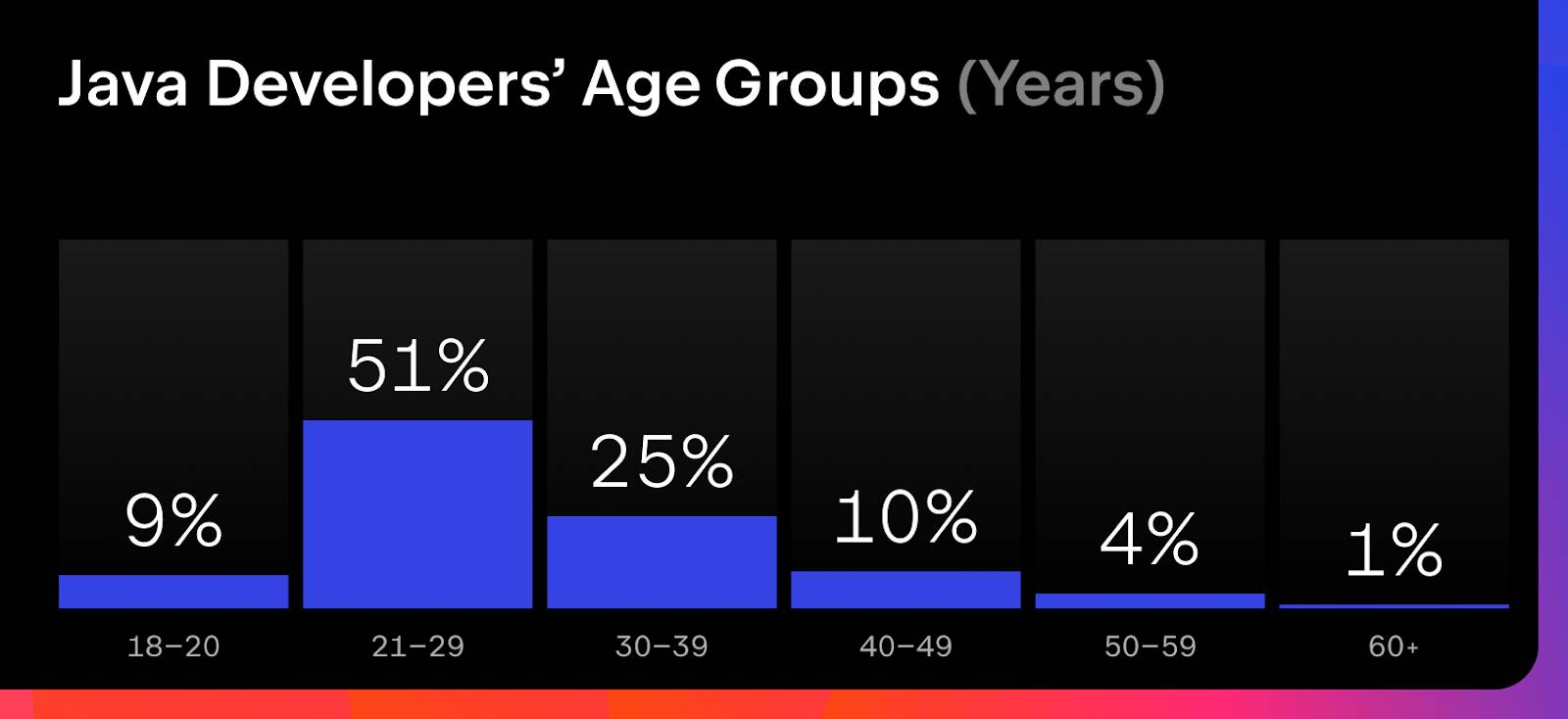
Education and occupation
A large number of Java developers (66%) work full time for a company or organization. Students and working students also account for a significant portion, making up 23%. Other job statuses include freelancers, self-employed, and partially employed.
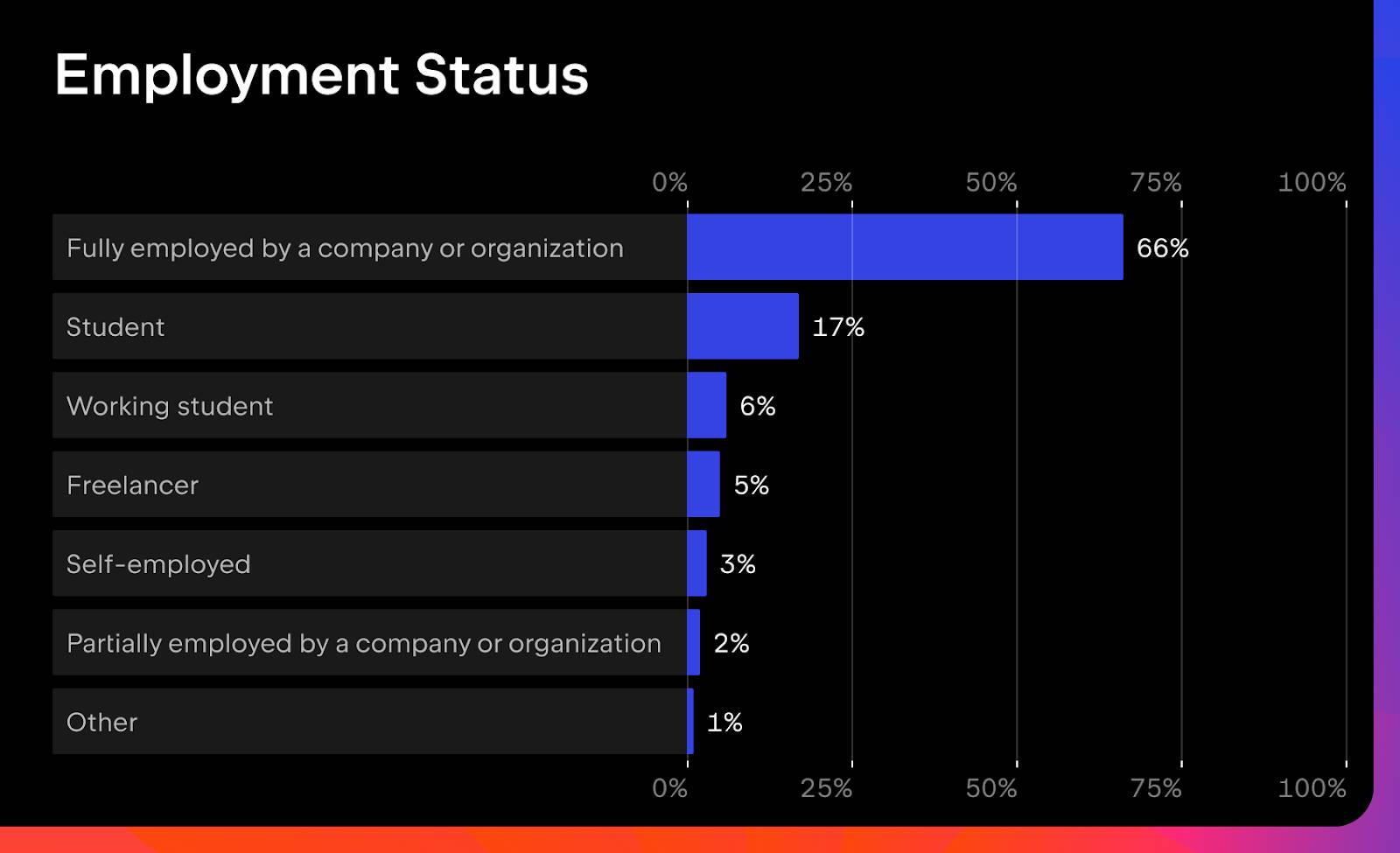
In terms of job roles, a significant majority identify as developers, programmers, or software engineers. Other notable roles include architect, DevOps engineer, team lead, and technical support specialist.
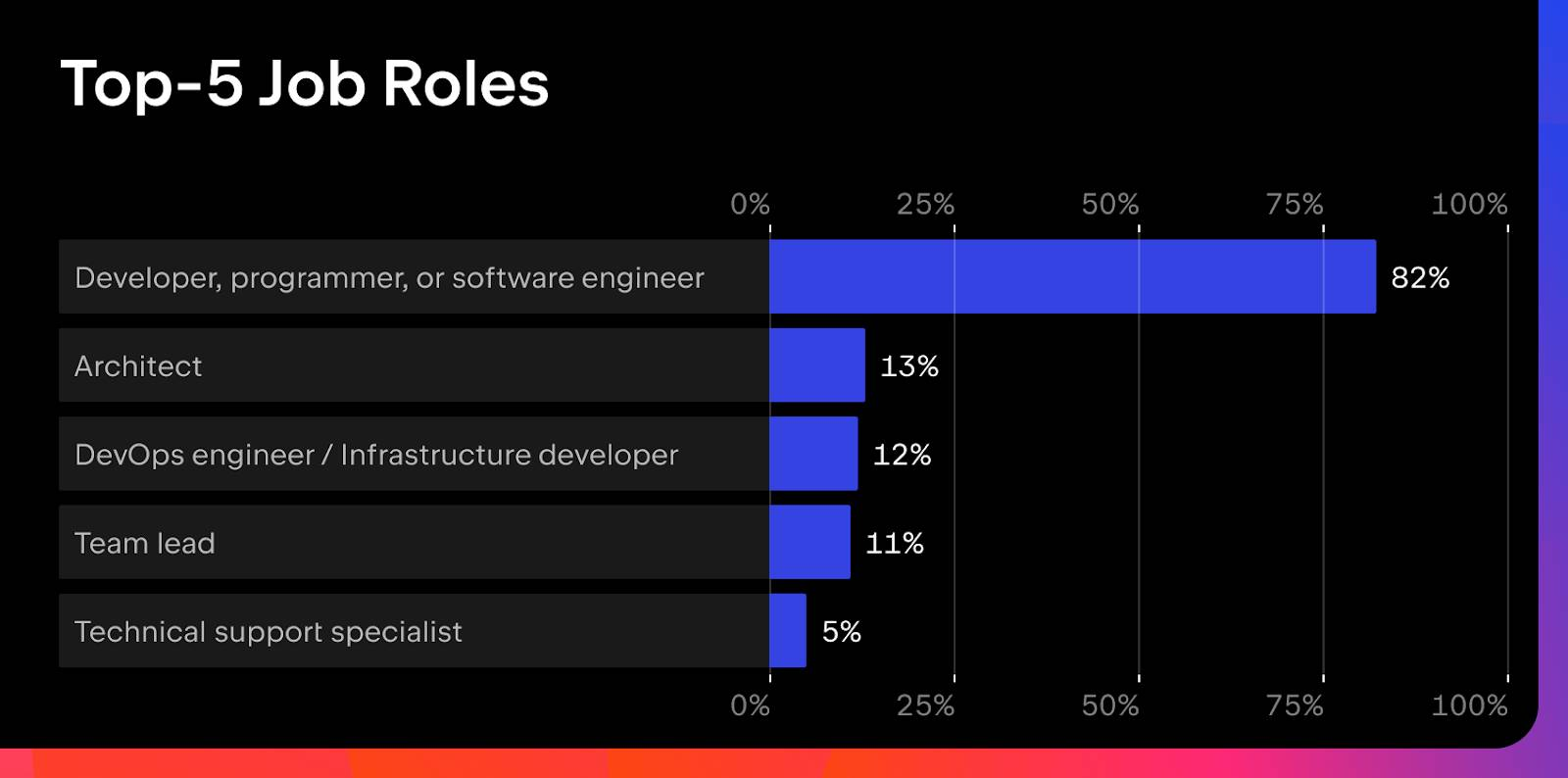
As for education, Java developers tend to have a strong academic foundation.
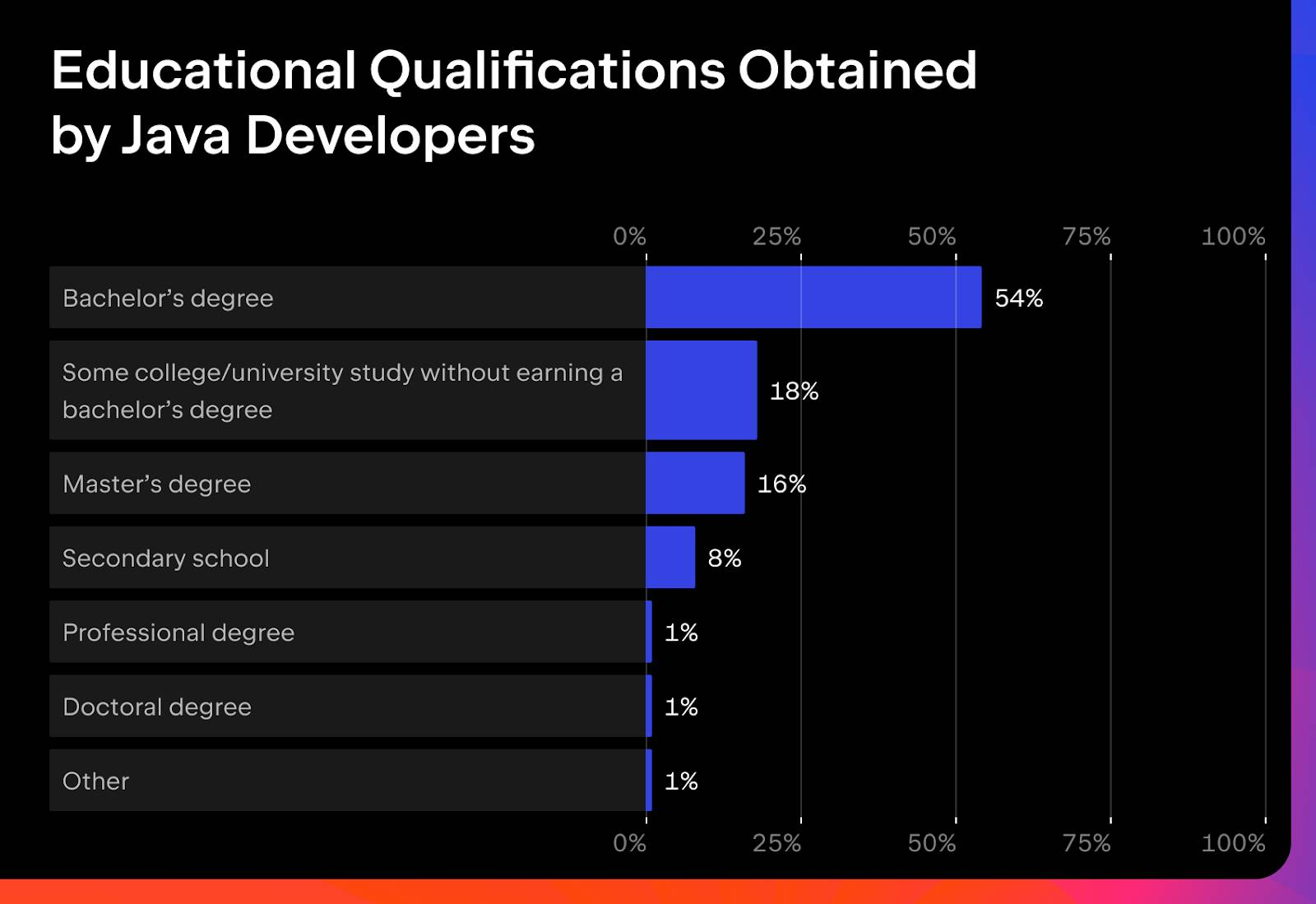
Work environments and tools
Professional Java developers heavily favor IntelliJ IDEA as their IDE of choice, with a remarkable 81% choosing JetBrains flagship product.
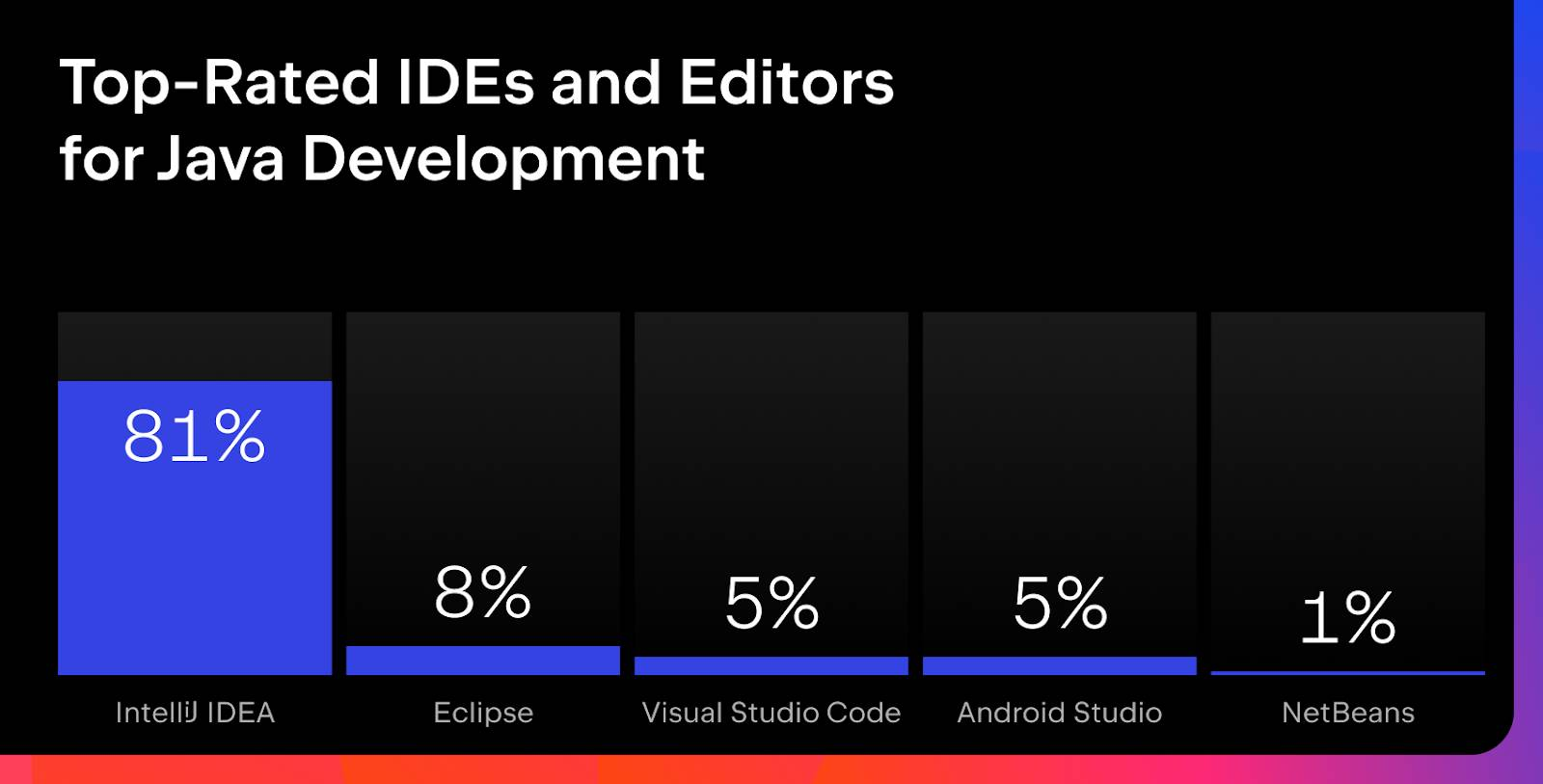
When it comes to operating systems, Windows is the dominant platform for development, with 69% of Java developers using it. Linux (43%) and macOS (42%) are also widely used, reflecting the varied preferences in the development community.
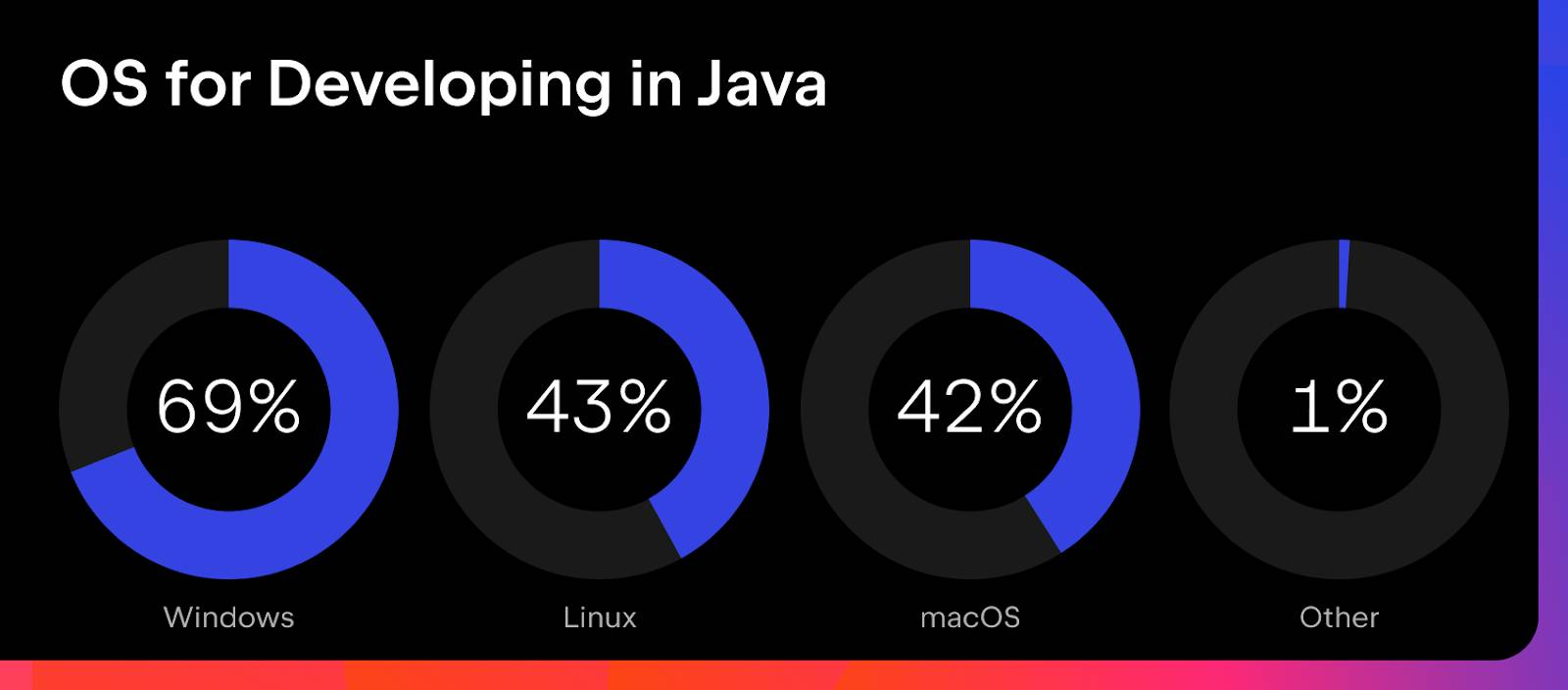
Writing assistance tools are not widely adopted, with 49% of developers not using any such tools. However, 36% use functionalities integrated into their working environment, and 18% use Grammarly.
As for the typical working environment, two monitors are the norm, with 60% of developers opting for two to enable multitasking.
Why choose to study Java nowadays?
Java may not be the trendiest language, but it’s still worth adopting. Here are a few reasons:
Career opportunities and salary
Java developers are always in demand, ensuring strong job prospects, career growth, and well-paying job opportunities, which makes it a smart financial choice.
For instance, 33% of new developers with less than one year of experience can expect to earn between $3,000 and $5,000 per month in the USA, according to Developer Ecosystem: Data Playground survey. This figure presents the net monthly salary distribution, excluding any bonuses.
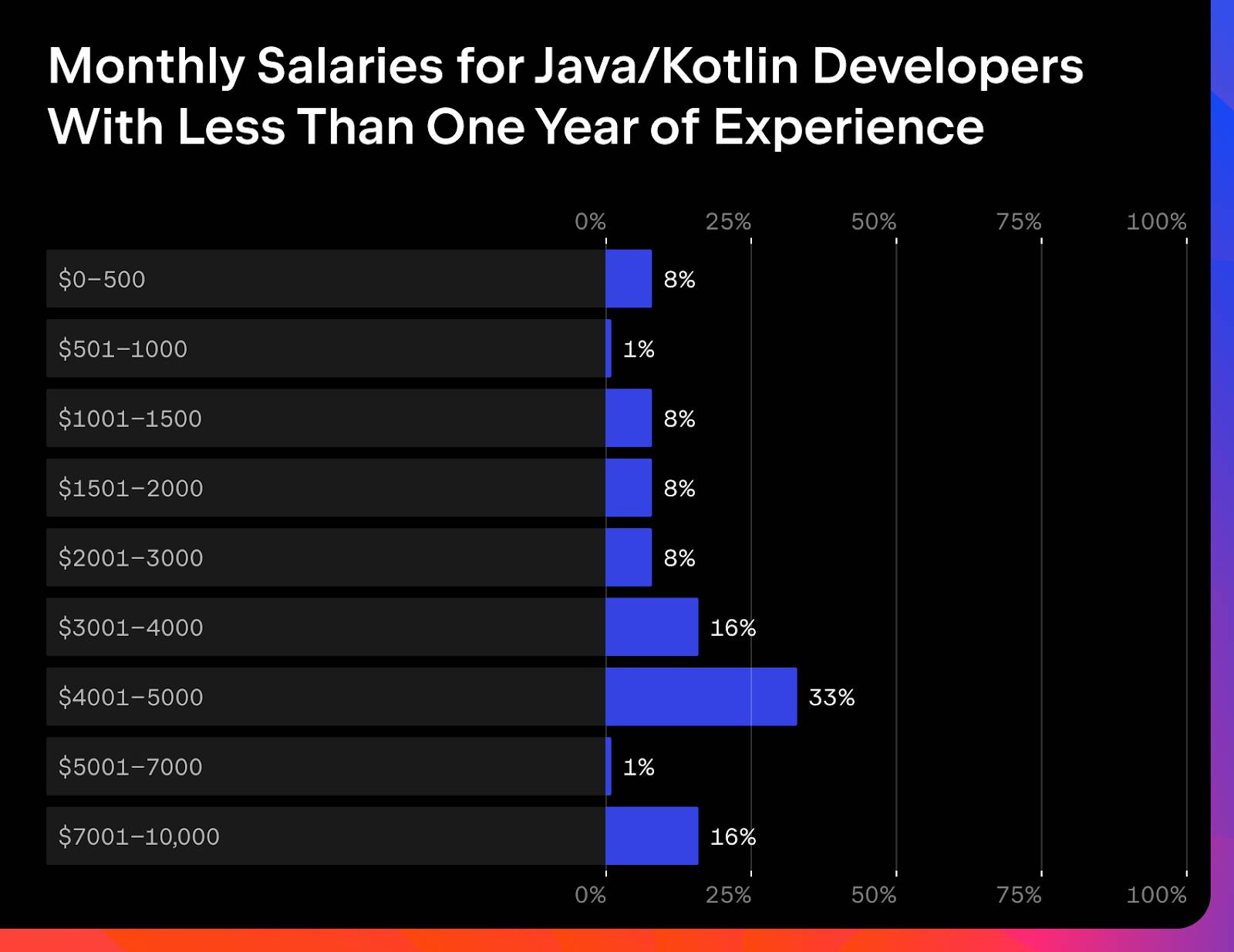
Educational foundation
Learning Java provides a strong foundation in object-oriented programming (OOP). Its syntax and concepts are similar to many other languages, making it easier to pick up additional languages later on. Understanding Java can serve as a stepping stone to other technologies, broadening your skill set and career opportunities.
Java remains one of the most popular languages taught in universities. In fact, 84% of the students who participated in the JetBrains Developer Ecosystem survey for 2023 reported studying Java in their educational institutions, and 64% mentioned that formal education allowed them to take their first steps toward becoming developers.
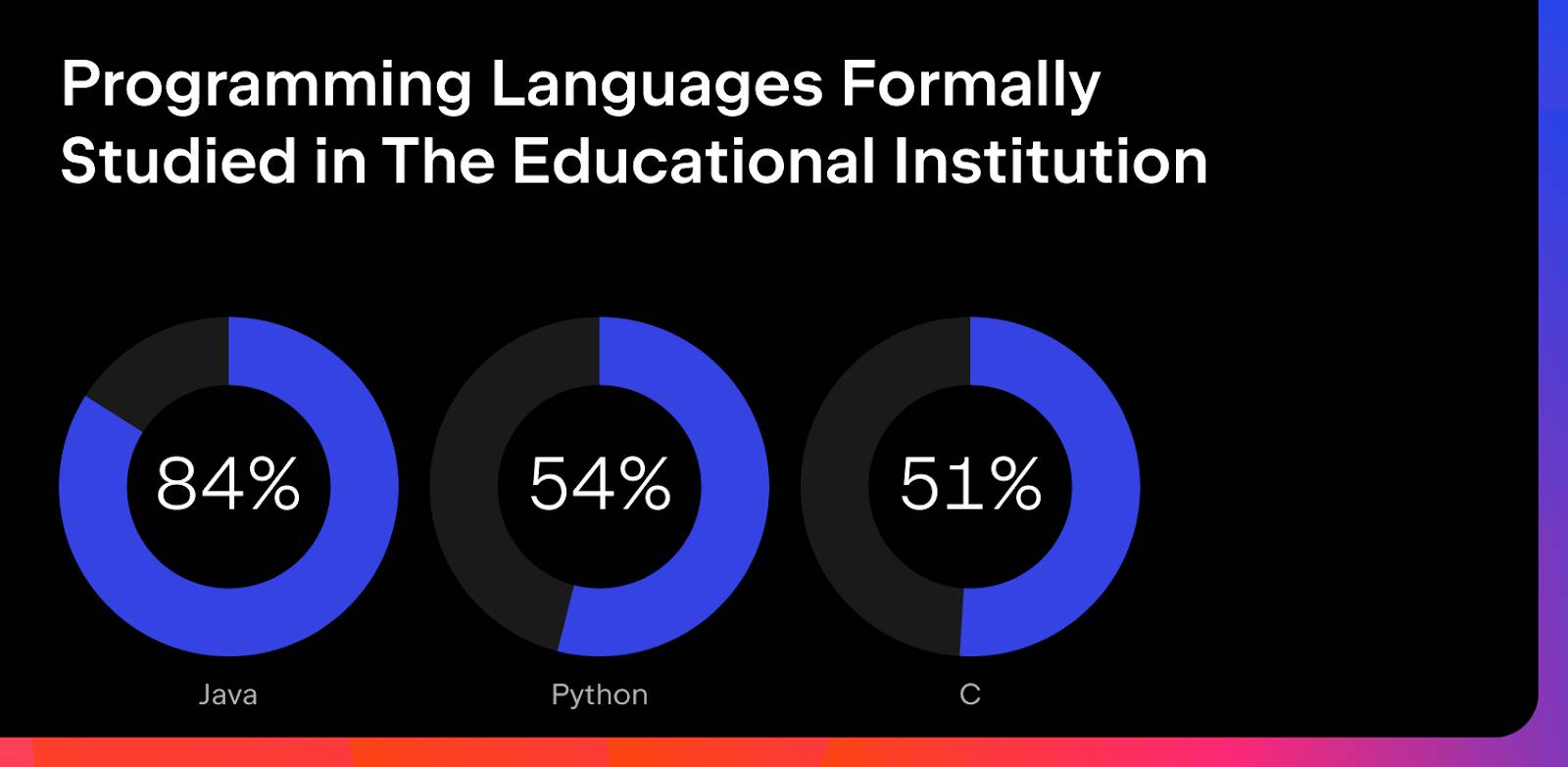
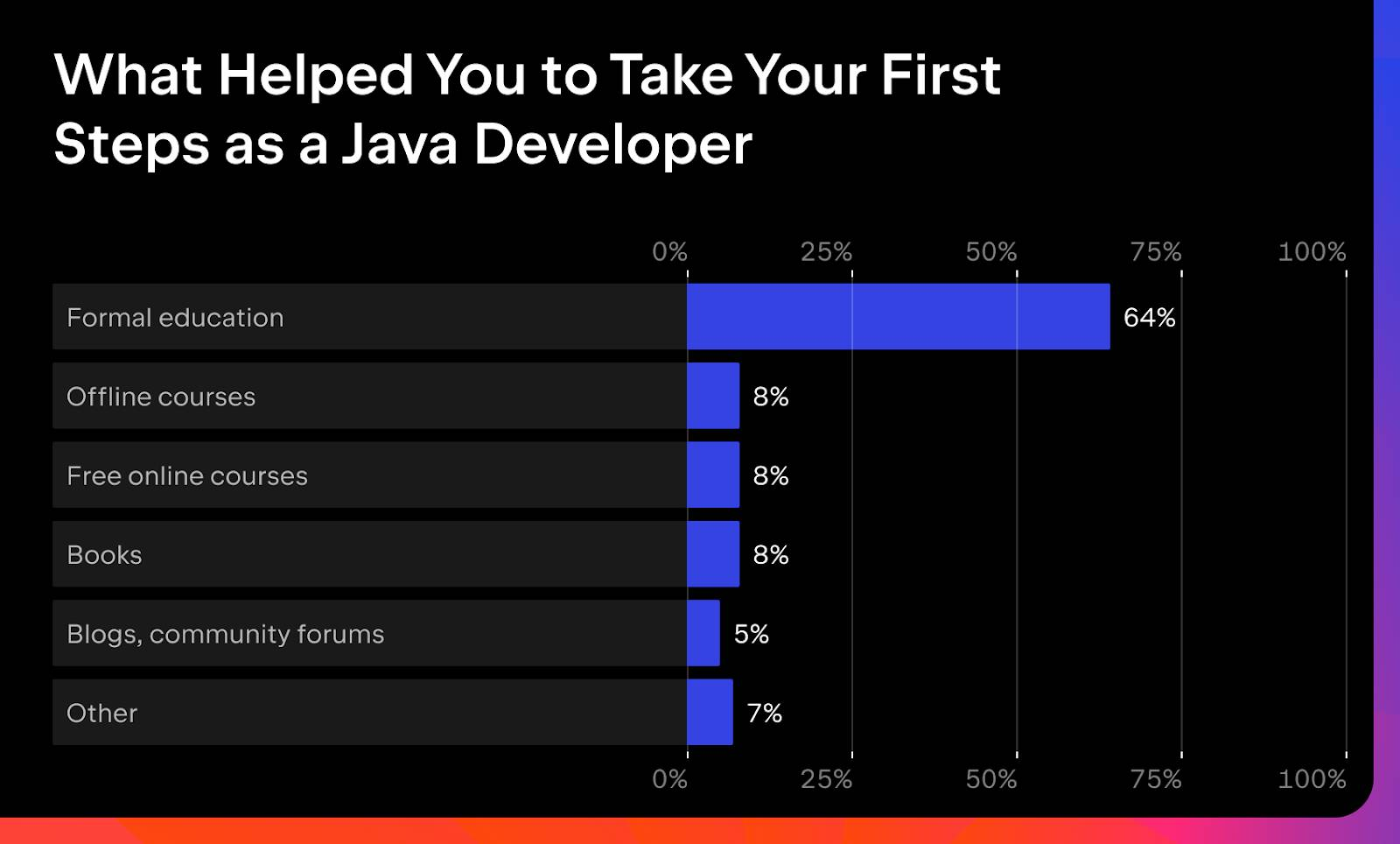
A positive trend for Java is that many new developers are still choosing to start learning the language. As the survey showed, Java is among the top five languages that people have chosen to study in 2023.

Java developer profile outside work
Now let’s uncover the unique experiences and preferences of Java developers beyond their professional roles. What are the joys and challenges faced by modern Java developers? What do they enjoy, and how do they manage their work-life balance?
Work-life balance
Work-life balance is crucial, but how does it apply to Java developers?
As the survey shows, the majority of developers finish work in the early evening, but a significant 16% work late into the night (after 22:00), which could ruin a healthy work-life balance.
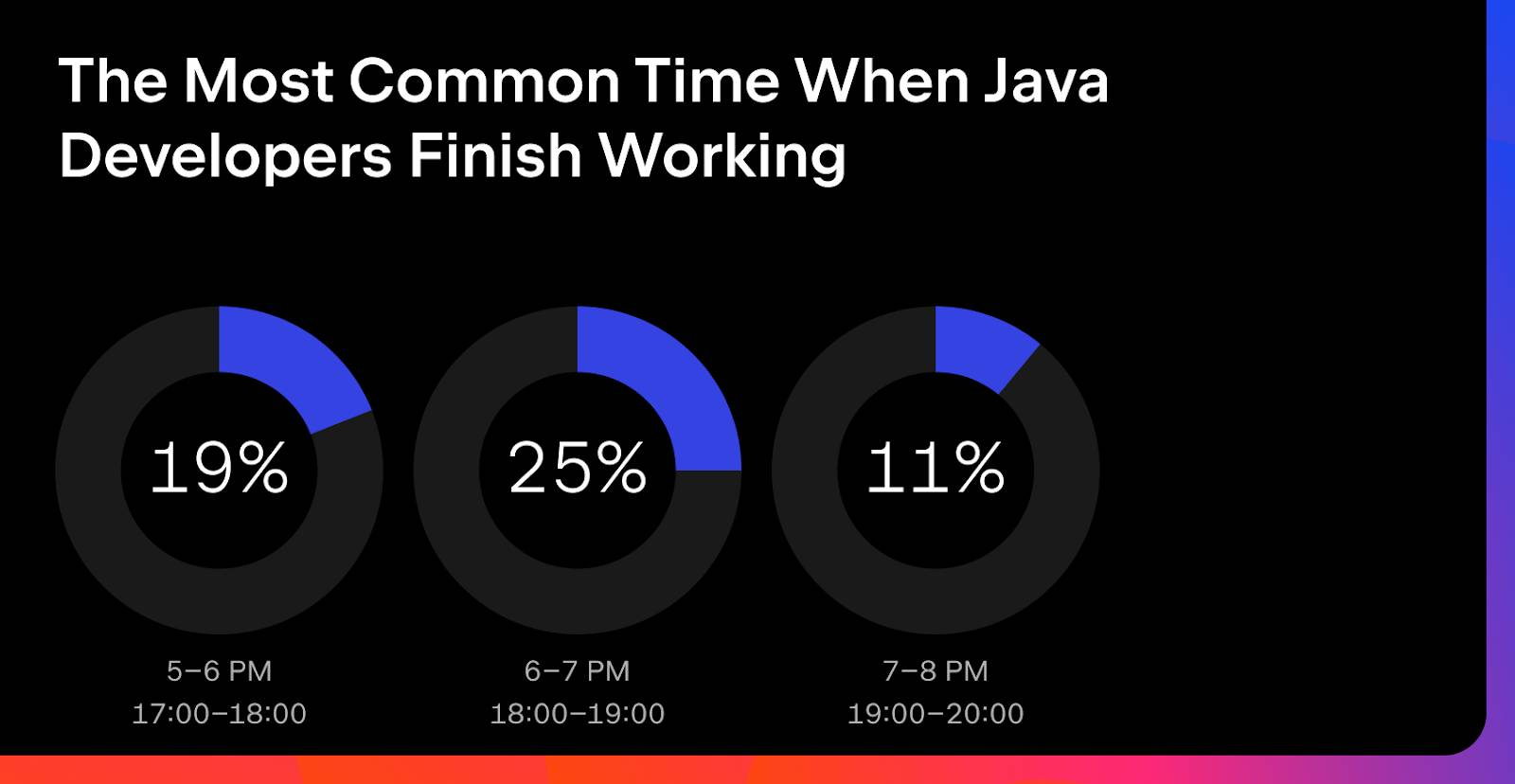
Also, many developers have a strong passion for coding, and 70% choose to code for fun, even during the weekends.
We found it interesting that Java developers are motivated not only by financial benefits but also by meaningful and impactful work. This means that when they see the results of their work, they may choose to work more but still feel balanced.
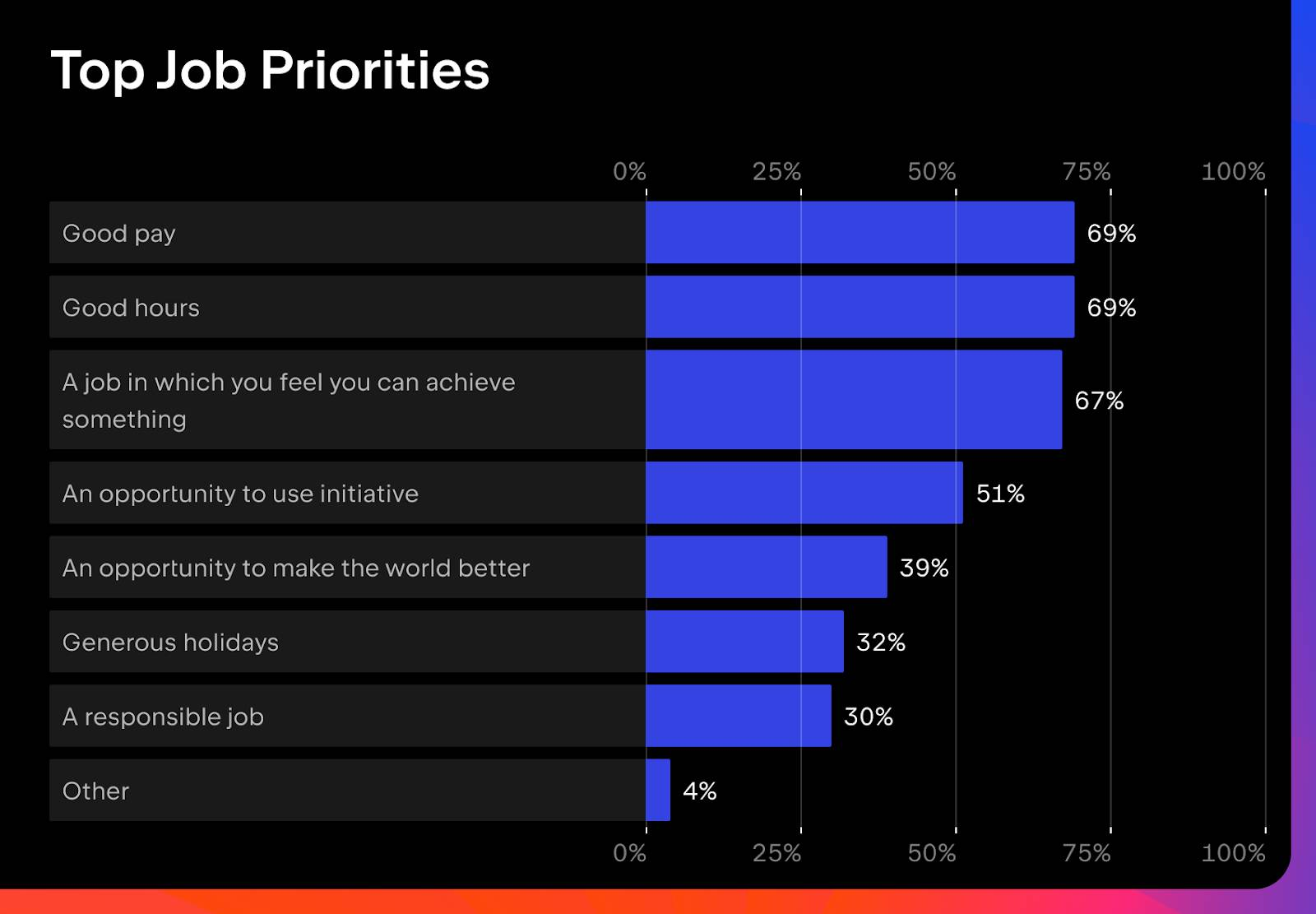
Assuming that Java developers love working on meaningful projects, maintaining productivity is essential. Let’s see what are the favorite productivity boots among Java developers.
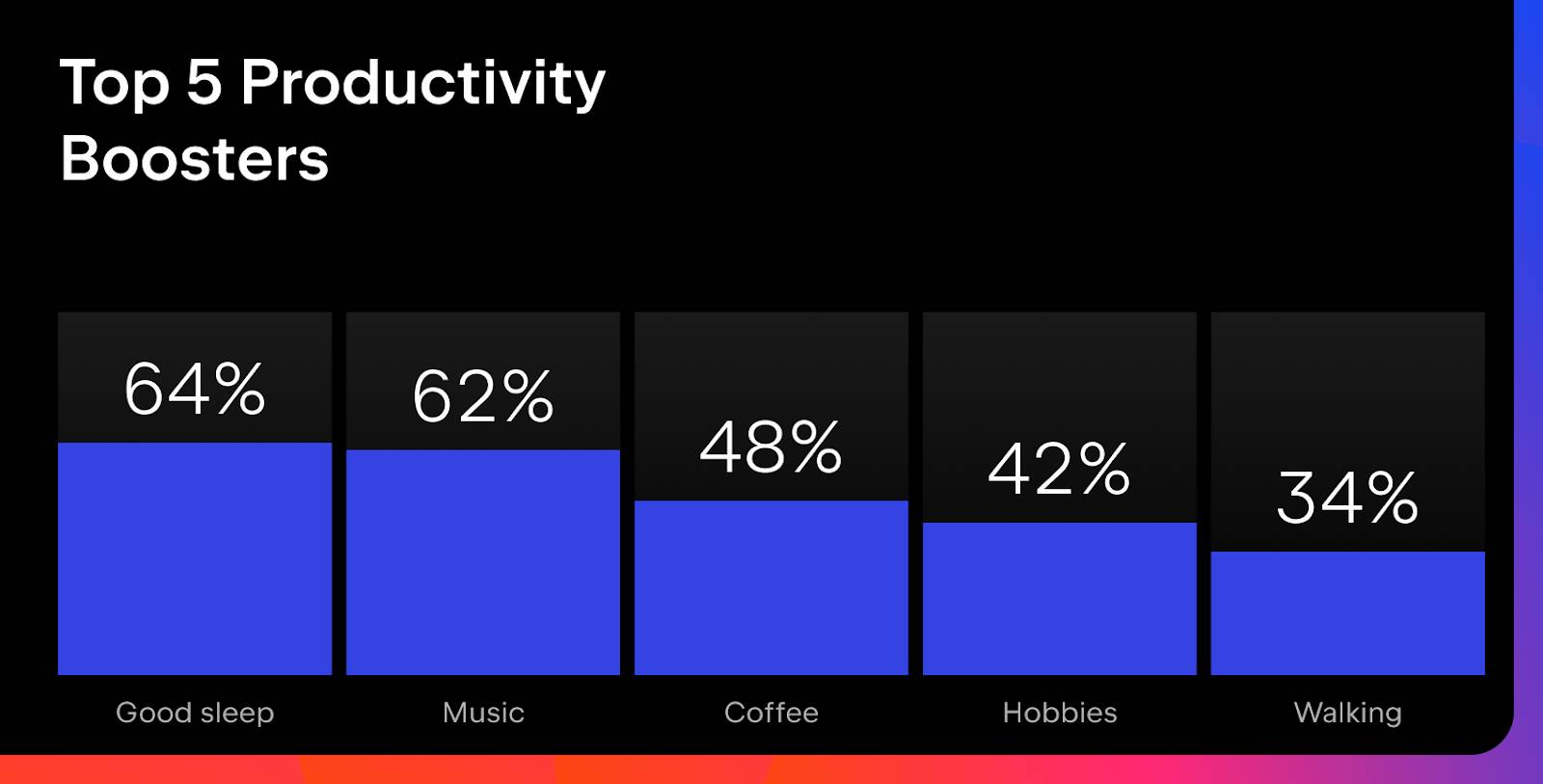
Flexible working hours, good sleep, and meaningful projects can make developers happier and their lives more balanced.
Free time and interests
Let’s explore how Java developers spend their free time, what hobbies and interests they have, and what else contributes to their overall well-being.
Java developers engage in a variety of hobbies during their free time.
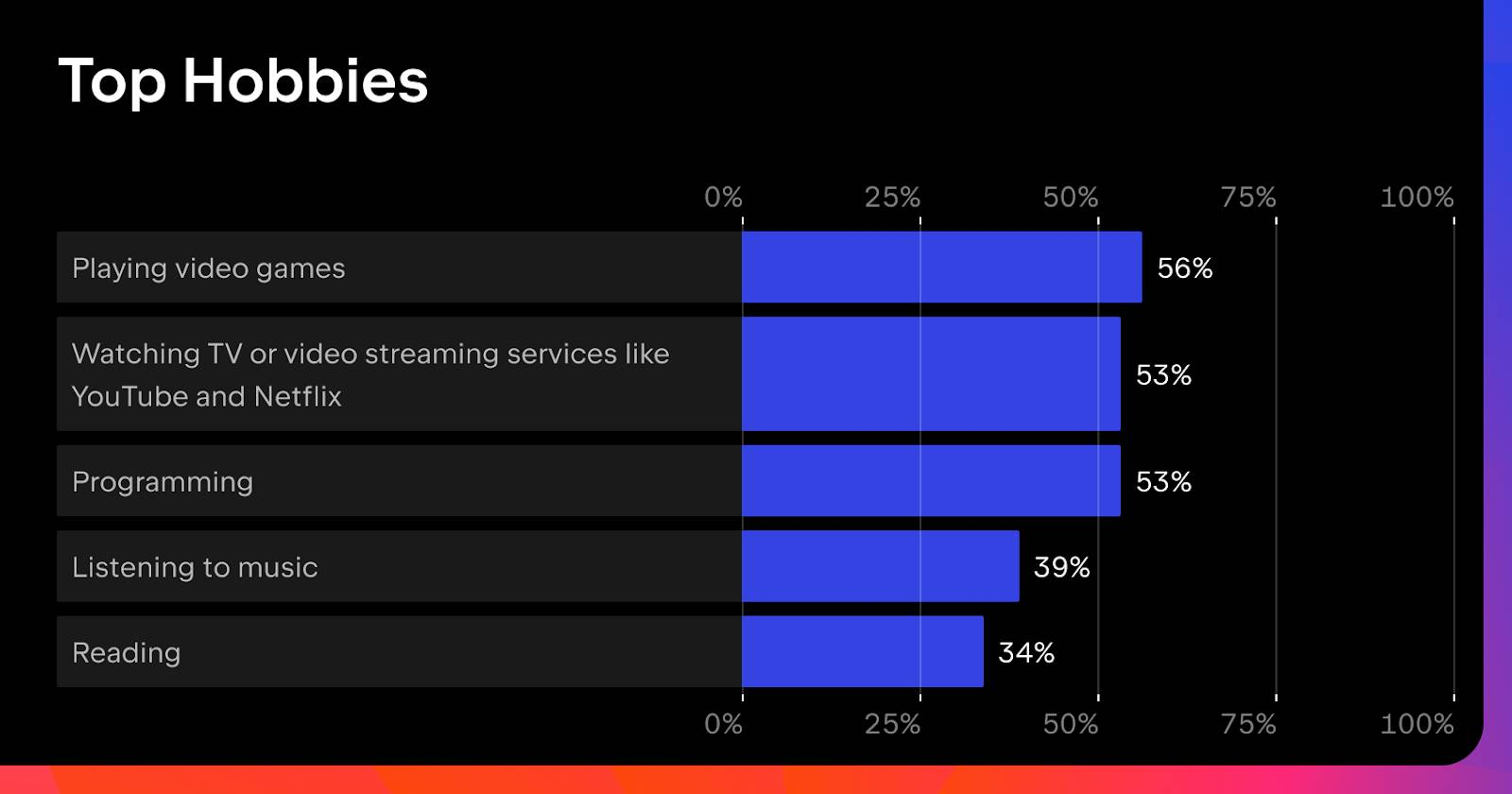
Since the majority of developers enjoy playing video games, we’ve asked them about their favorite genres, which include action games (48%), RPGs (47%), adventure games (45%), and strategic games (42%).
Are Java developers sporty?
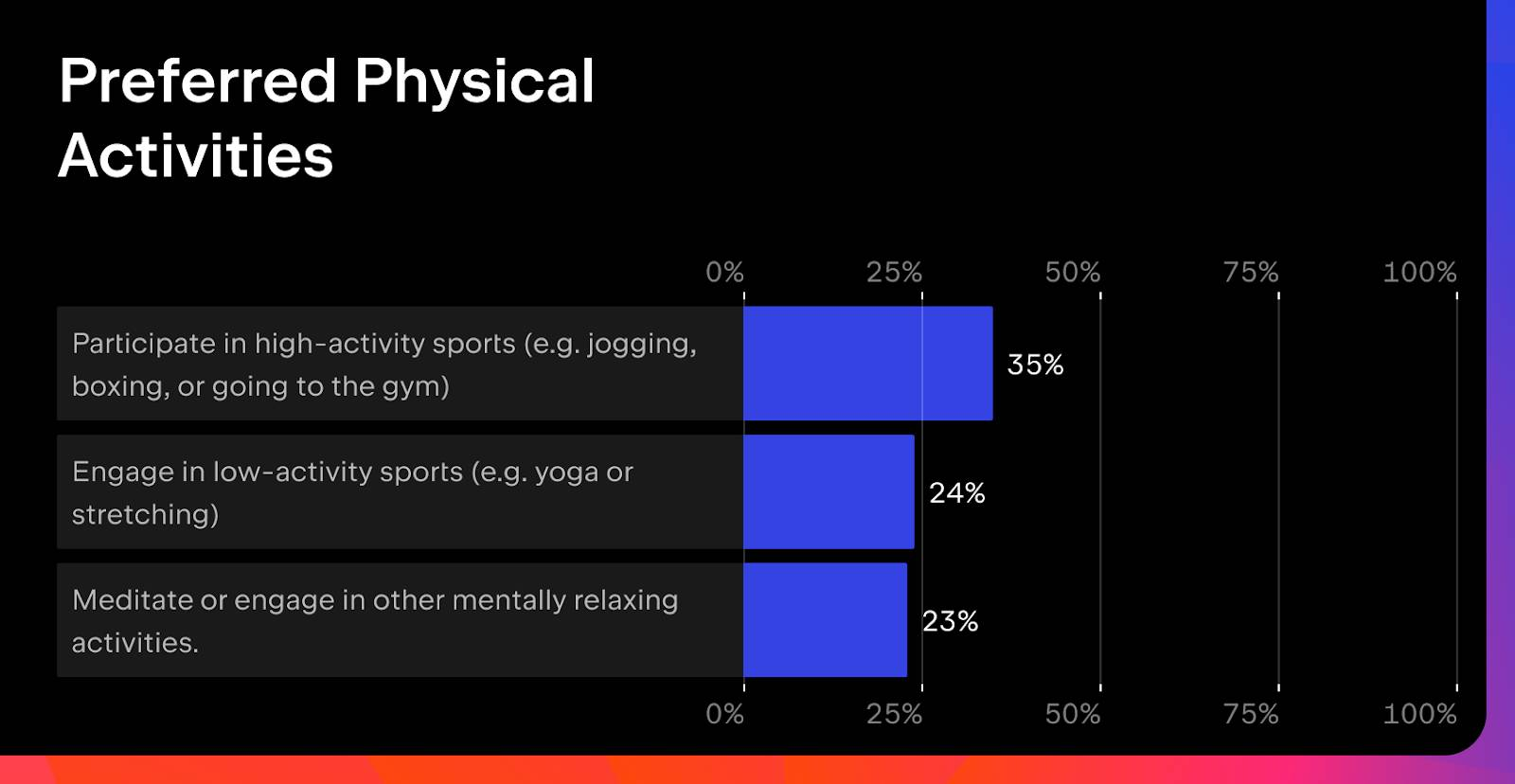
Java developers have many interests, which shows that they are eager to learn and grow in different areas.
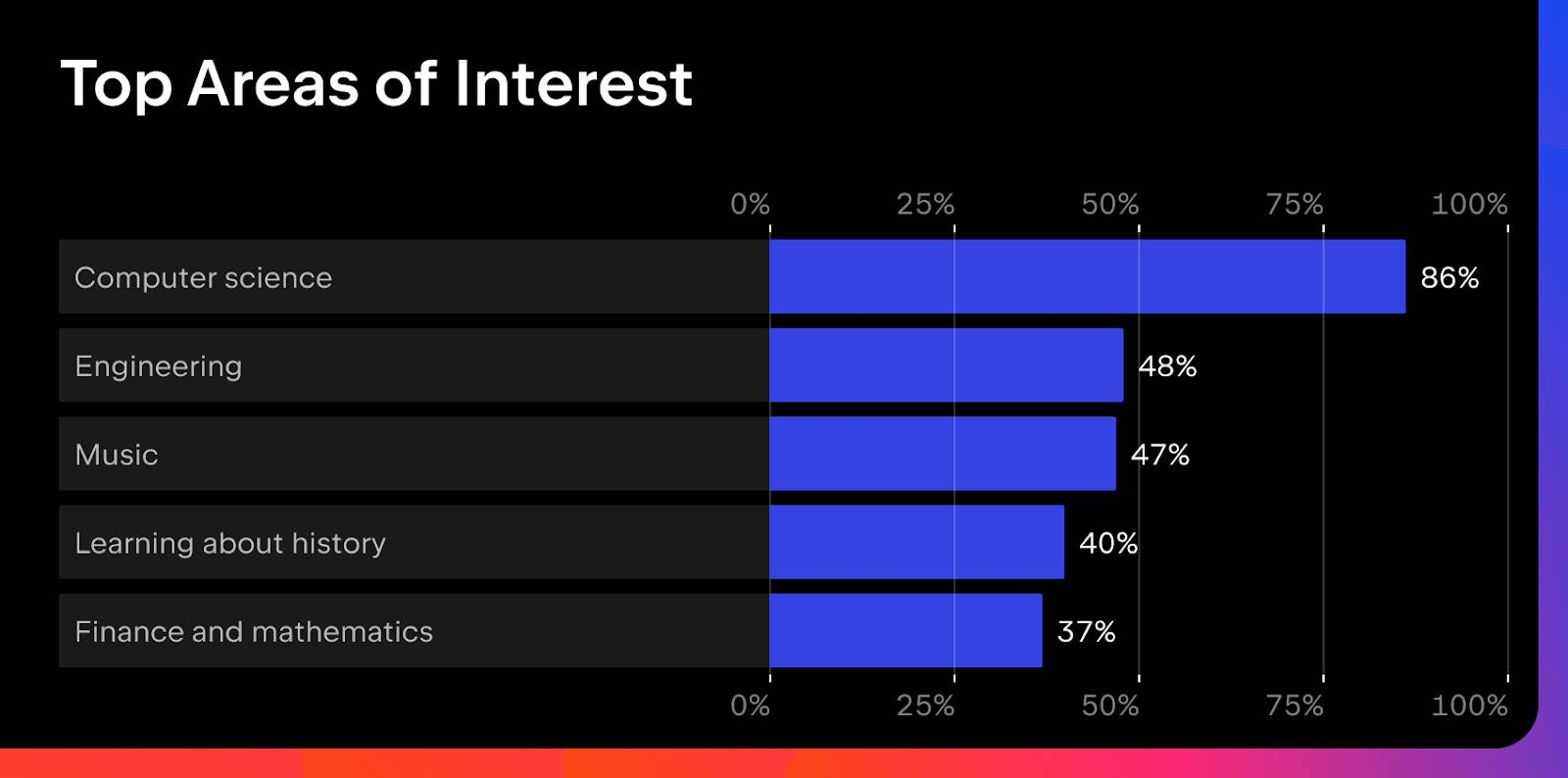
What about social media? They overwhelmingly have personal accounts on the following websites and regularly browse them:

And finally, the most important insight in our overview. This might just be the data point that helps you determine if you identify as a Java developer!
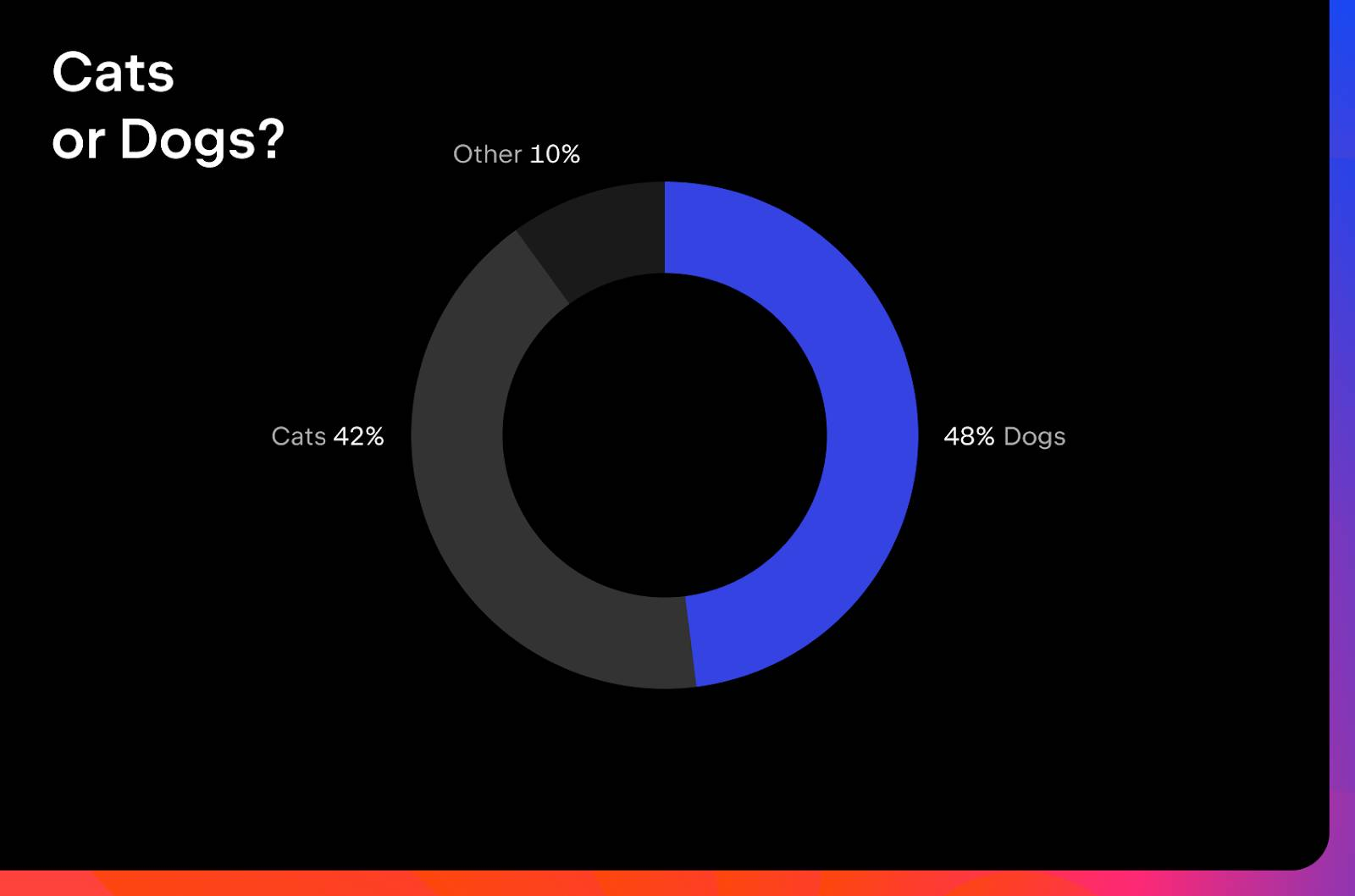
Conclusion
With the help of The State of Developer Ecosystem 2023 and 2022 surveys, we’ve found out that Java remains a key player in the tech world, powering enterprise software, mobile apps, and smaller utilities. Thus, learning Java provides a strong foundation in programming and opens doors to lucrative careers.
We’ve also presented some interesting data about modern Java developers, their lifestyles, life priorities, hobbies, and many other details.
After reading this overview, what do you think about Java’s role today? If you’re not already, do you see yourself as a Java developer in the future? Share your thoughts in the comments below!
*Despite all the measures we’ve taken to secure a representative pool of respondents, the results may be slightly shifted towards JetBrains product users, as they are more likely to take the survey.
